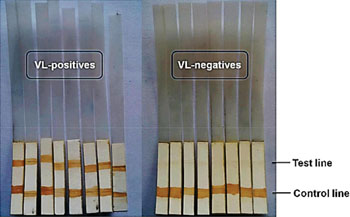Urine-Based Immunoassays Developed for Visceral Leishmaniasis
By LabMedica International staff writers
Posted on 04 Nov 2016
Visceral Leishmaniasis (VL), a severe parasitic disease, and can be fatal if diagnosis and treatment is delayed and diagnostic tests available for VL such as tissue aspiration are invasive and painful although they are capable of evaluating the treatment response.Posted on 04 Nov 2016
Post kala-azar dermal leishmaniasis (PKDL), a skin related outcome, is a potential reservoir for the spread of VL and parasitological examination of slit-skin smear along with the clinical symptoms is routinely used for diagnosis of PKDL. Therefore, a noninvasive test with acceptable sensitivity and competency, additionally, to decide cure would be an asset in disease management and control.

Image: A dipstick immunochromatographic test shows positive results for visceral leishmaniasis with double band at the test and control lines and negative results with bands only at the control line (Photo courtesy of the Indian Institute of Chemical Biology).
Infectious disease specialists at the Indian Institute of Chemical Biology (Kolkata, India) enrolled 186 participants during March 2011 to July 2016. Urine samples of 97 parasitologically proven and rK39-RDT tested VL cases were obtained before the treatment started. Out of 97 VL samples, 18 were acquired for longitudinal study at different time points. Samples were also collected from 75 control subjects and 14 urine samples, which were confirmed by skin biopsy or slit-skin smear were collected from PKDL patients.
The team also performed enzyme-linked immunosorbent assays (ELISA) and the optical densities were read at 492 nm. The scientists also carried out dot blot assays and a nitrocellulose membrane-based dipstick was prepared to have a test and a control line for visual detection of the disease. Like dot blot assay the dipstick test comprises incubation with urine sample followed by enzyme-conjugated anti-human immunoglobulin G (IgG) and then substrate chromogen including washing in each step. Dark brown colored bands both at the test and control line show VL positivity and a single band at the control line infers VL negativity.
The team found that the ELISA and dipstick test were extremely effective for diagnosis of VL and PKDL through urine samples thus, may substitute the existing invasive diagnostics. Utility of these tests as indirect methods of monitoring parasite clearance can define infected versus cured. Urine-based dipstick test is simple, sensitive and above all noninvasive method that may help not only in active VL case detection but also to ascertain treatment response. It can therefore, be deployed widely for interventions in disease management of VL particularly in poor resource settings. The study was published on October 14, 2016, in the journal Public Library of Science Neglected tropical Diseases.
Related Links:
Indian Institute of Chemical Biology







 Analyzer.jpg)






